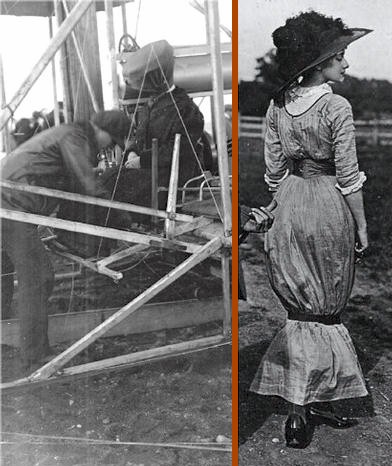 The Origin of the
The Origin of the
Hobble Skirt

Left, Wilbur ties a
string around Katharine's dress prior to flight; right, the hobble skirt. The
one did not beget the other.
Tight skirts with small-circumference hems had been in and out of fashion in Europe since the 1880s, long before the Wrights arrived with their airplane. Late Victorian designers called attention to the posteriors of women by hiding them beneath an erotic "bustle," then emphasized the hips and legs with clinging skirts. Some of these designs were inspired by a growing fascination with the orient. Japan had recently been opened to trade with the world at large by the Convention of Kanagawa in 1854. Since then, the kimono and the "gheisha" look had become recurring themes in Western women's wear.
This "orientalism," as the design movement was called, got a huge boost in France from the Paris-based dance troupe Ballet Russes under the direction of Sergei Diaghilev. In 1910, they produced a wildly successful musical show called Scheherazade which featured orient-inspired costumes. These costumes had an enormous effect on French fashion.
When Katharine visited Europe in 1909, the most influential fashion designer was Paul Poiret, a French couturier. Poiret's designs were often exotic, drawing on Egyptian and oriental motifs. The popularity of Scheherazade gave new impulse to Poiret's orientalism and in 1910 he introduced a tight-fitting dress with a restrictive hem that forced the wearer to take dainty geisha-like steps. This became known as the hobble skirt and it remained an object of fashion – and ridicule – for several years thereafter. Poiret never claimed to have been inspired by Katharine or any other aviatrix; by his own telling his purpose was simply to emphasize the womanly shape.
Katharine's connection to the hobble skirt seems to have begun after an article appeared in the New York Times in 1910, "The Hobble is the Latest Freak in Women's Fashion." The author did not mention Katharine but referred to an "aviation skirt" worn by Mme. Alice Bleriot, the wife of Louis Bleriot who had flown across the English Channel in 1909. It was sloppy journalism; there was no "aviation skirt" nor was Mme. Bleriot known to fly with her husband. But the article reflected on other women who flew, one of the most popular being Katharine Wright.